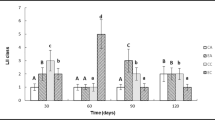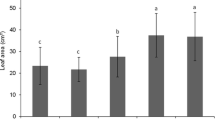Abstract
A biomonitoring study using the ozone-sensitive bioindicator plant Nicotiana tabacum cv. Bel-W3 was conducted in the city of Valencia (eastern Spain) and surrounding areas in 2002. Plants were exposed to ambient air at seven sites, including four traffic-exposed urban sites, a large urban garden and a suburban and a rural station, for six consecutive 2-week periods using highly standardised methods. Foliar injury was registered at all stations in at least one of the exposure periods. The urban stations submitted to intense traffic showed lower ozone injury than the less traffic-exposed stations. Strong changes in the intensity of ozone injury were observed for the different exposure periods. Leaf injury was significantly related to both mean ozone values (24 and 12 h means) and cumulative exposure indices (AOT20, AOT40). However, correlation strength was moderate (r s = 0.39 to 0.58), suggesting that the plant response to ozone was modified by environmental factors. The use of sensitive bioindicators like tobacco Bel-W3 in cities provides complementary information to that of continuously operating air quality monitors, as the impact of ambient ozone levels is directly measured.





Similar content being viewed by others
References
Arndt, U., Erhardt, W., Keitel, A., Michenfelder, K., Nobel, W., & Schlüter, C. (1985). Standardisierte Exposition von pflanzlichen Reaktionsindikatoren. Staub – Reinhaltung der Luft, 45, 481–483.
Ashmore, M. R., Bell, J. N. B., & Reily, C. L. (1978). A survey of ozone levels in the British Isles using bioindicator plants. Nature, 276, 813–814.
Calatayud, V., & Sanz, M. J. (2004). Ozone bioindication with tobacco Bel-W3 in schools of Valencia. In A. Klumpp, W. Ansel & G. Klumpp (Eds.), Urban air pollution, bioindication and environmental awareness (pp. 191–195). Göttingen: Cuvillier Verlag.
Chameides, W. L., & Lodge, J. P. (1992). Tropospheric ozone: Formation and fate. In A. S. Lefohn (Ed.), Surface-level ozone exposures and their effects on vegetation (pp. 5–30). Chelsea, MI: Lewis.
European Union (EU) (2002). Directive 2002/3/EC of the European Parliament and of the Council of 12 February 2002 relating to ozone in ambient air. Official Journal of the European Communities, L 67/14–30.
Fumagalli, I., Gimeno, B. S., Velissariou, D., De Temmerman, L., & Mills, G. (2001). Evidence of ozone-induced adverse effects on crops in the Mediterranean region. Atmospheric Environment, 35, 2583–2587.
Godzik, B. (1997). Ground level ozone concentrations in the Kraków Region, Southern Poland. Environmental Pollution, 98, 273–280.
Klumpp, A., Ansel, W., Klumpp, G., Belluzzo, N., Calatayud, V., Chaplin, N., et al. (2002). EuroBionet: A Pan-European biomonitoring network for urban air. Environmental Science and Pollution Research, 9, 199–203.
Klumpp, A., Ansel, W., Klumpp, G., Calatayud, V., Garrec, J. P., He, S., et al. (2006a). Ozone pollution and ozone biomonitoring in European cities. Part I. Ozone concentrations and cumulative exposure indices at urban and suburban sites. Atmospheric Environment, 40, 7963–7974.
Klumpp, A., Ansel, W., Klumpp, G., & Pickl, C. (2000). European network for the assessment of air quality by the use of bioindicator plants. Manual of methods. (University of Hohenheim, Germany).
Klumpp, A., Ansel, W., Klumpp, G., Vergne, P., Sifakis, N., Sanz, M. J., et al. (2006b). Ozone pollution and ozone biomonitoring in European cities Part II. Ozone-induced plant injury and its relationship with descriptors of ozone pollution. Atmospheric Environment, 40, 7437–7448.
Klumpp, A., Klumpp, G., & Ansel, W. (2004). Urban air quality in Europe – Results of three years of standardised biomonitoring studies. In A. Klumpp, W. Ansel & G. Klumpp (Eds.), Urban air pollution, bioindication and environmental awareness (pp. 25–50). Göttingen: Cuvillier Verlag.
Kostka-Rick, R. (2003). Ozone biomonitoring: How relevant are results from tobacco (Nicotiana tabacum) cv. ‘Bel W3’? (Poster presented at the SETAC Europe 13th Annual Meeting, Hamburg). Available at: http://www.biomonitoring.com/d/pp.html.
Krupa, S., & Legge, A. (2000). Passive sampling of ambient, gaseous air pollutants: An assessment from an ecological perspective. Environmental Pollution, 107, 31–45.
Krupa, S. V., Manning, W. J., & Nosal, M. (1993). Use of tobacco cultivars as biological indicators of ambient ozone pollution: An analysis of exposure–response relationships. Environmental Pollution, 81, 137–146.
Lorenzini, G., Nali, C., & Biagioni, M. (1995). Long range transport of photochemical ozone over the Tyrrhenian Sea demonstrated by a new miniaturized bioassay with ozone-sensitive tobacco seedlings. Science of the Total Environment, 166, 193–199.
Millán, M. M., Mantilla, E., Salvador, R., Carratalá, A., Sanz, M. J., Alonso, L., et al. (2000). Ozone cycles in the Western Mediterranean Basin: Interpretation of monitoring data in complex coastal terrain. Journal of Applied Meteorology, 39, 487–508.
Millán, M. M., Salvador, R., Mantilla E., & Kallos, G. (1997). Photo-oxidant dynamics in the Mediterranean basin in summer: Results from European Research Projects. Journal of Geophysical Research, 102 no.D7, 8811–8823.
Nali, C., Ferretti, M., Pellegrin, M., & Lorenzini, G. (2001). Monitoring and biomonitoring of surface ozone in Florence, Italy. Environmental Monitoring and Assessment, 69, 159–174.
Nali, C., Francini, A., & Lorenzini, G. (2006). Biological monitoring of ozone: The twenty-year Italian experience. Journal of Environmental Monitoring, 8, 25–32.
Ribas, A., Filella, I., Gimeno, B. S., & Peñuelas, J. (1998). Evaluation of tobacco cultivars as bioindicators and biomonitors of ozone phytotoxical levels in Catalonia. Water, Air and Soil Pollution, 107, 347–365.
Ribas, A., & Peñuelas, J. (2003). Biomonitoring of tropospheric ozone phytotoxicity in rural Catalonia. Atmospheric Environment, 37, 63–71.
Sanz, M. J., Calatayud, V., & Sanchez, G. (2007). Measures of ozone concentrations using passive sampling in forests of South Western Europe. Environmental Pollution, 145, 620–628.
Sanz, M. J., & Millán, M. M. (1998). The dynamics of aged air mases and ozone in the western Mediterranean: Relevance to forest ecosystems. Chemosphere, 98, 1089–1094.
Sanz, M. J., & Millán, M. M. (2000). Ozone in the Mediterranean Region: Evidence of injury to Vegetation. In J. L. Innes & J. Oleskyn (Eds.), Forest dynamics in heavily polluted regions (pp. 165–192). London: CAB International.
Sanz, M. J., Sanz, F., & Sanchez, G. (2001). Spatial and annual temporal distribution of ozone concentrations in the Madrid Basin using passive samplers. [Electronic version]. The Scientific World Journal, 1, 785–795.
Verein Deutscher Ingenieure (VDI) (2003). Biological measuring techniques for the determination and evaluation of effects of air pollutants on plants (bioindication). Determination and evaluation of the phytotoxic effect of photooxidants. Method of the standardised tobacco exposure. (Beuth, Düsseldorf: VDI-Guideline 3957 Part 6).
Acknowledgements
This study was supported by the LIFE Environment Programme of the European Commission, DG Environment, under the grant LIFE/99/ENV/D/000453. We thank the Ayuntamiento de Valencia, Oficina Técnica de la Devesa-Albufera (A. Vizcaino, A. Quintana) for their valuable help in this study. José Jaime Diéguez helped to process the air monitoring data. Fundación CEAM members are also indebted to Generalitat Valenciana and Fundación Bancaja for continuous support to the activities of the Foundation.
Author information
Authors and Affiliations
Corresponding author
Rights and permissions
About this article
Cite this article
Calatayud, V., Sanz, M.J., Calvo, E. et al. Ozone Biomonitoring with Bel-W3 Tobacco Plants in the City of Valencia (Spain). Water Air Soil Pollut 183, 283–291 (2007). https://doi.org/10.1007/s11270-007-9376-2
Received:
Accepted:
Published:
Issue Date:
DOI: https://doi.org/10.1007/s11270-007-9376-2




